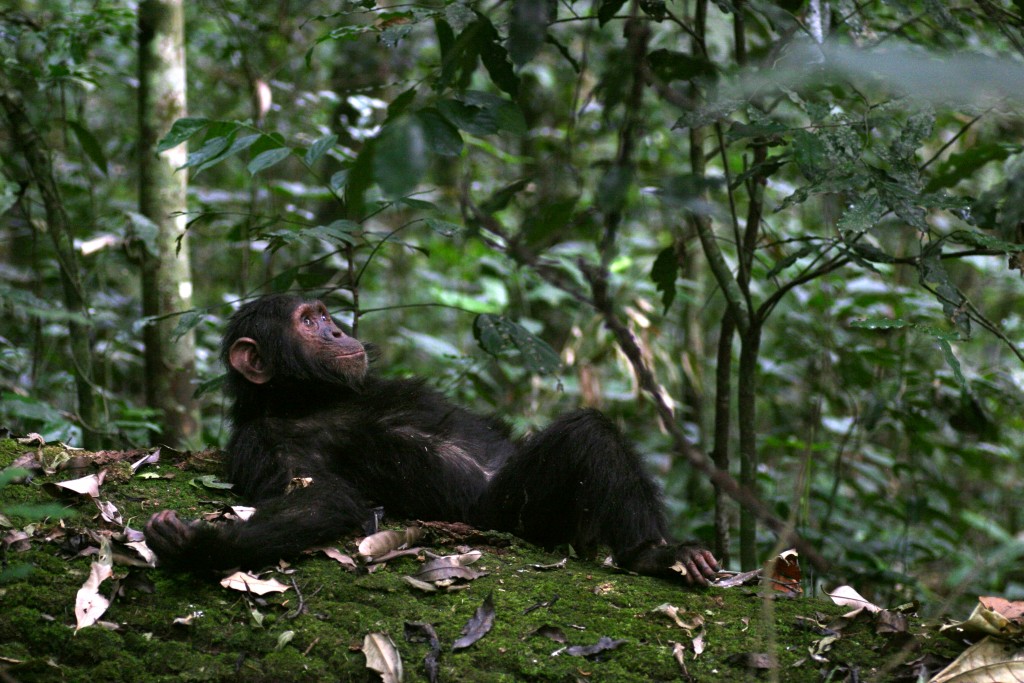 Chimpanzees and their “sister species”, bonobos, are together the closest living relatives of humans. Genetics data indicate that the evolutionary lineage leading to these African great apes diverged from that leading to humans about 6 million years ago. Disagreement about chimpanzee taxonomy exists, but most researchers assign all chimpanzees to the species Pan troglodytes, which is subdivided into four subspecies and, less formally, into “western”, “central”, and “eastern” chimpanzees. As these labels imply, chimpanzees are distributed broadly, but discontinuously, across Africa from Mali in the west and Angola in the southwest to Uganda and Tanzania in the east. Eastern chimpanzees (Pan troglodytes schweinfurthii) occur in scattered, disjunct populations in Uganda, Tanzania, Rwanda, Burundi, and the eastern Democratic Republic of Congo.
Chimpanzees and their “sister species”, bonobos, are together the closest living relatives of humans. Genetics data indicate that the evolutionary lineage leading to these African great apes diverged from that leading to humans about 6 million years ago. Disagreement about chimpanzee taxonomy exists, but most researchers assign all chimpanzees to the species Pan troglodytes, which is subdivided into four subspecies and, less formally, into “western”, “central”, and “eastern” chimpanzees. As these labels imply, chimpanzees are distributed broadly, but discontinuously, across Africa from Mali in the west and Angola in the southwest to Uganda and Tanzania in the east. Eastern chimpanzees (Pan troglodytes schweinfurthii) occur in scattered, disjunct populations in Uganda, Tanzania, Rwanda, Burundi, and the eastern Democratic Republic of Congo.
Chimpanzees are omnivores that eat a wide range of foods, including meat, but most of their diet comes from plants. Fruit is the main dietary component, and chimpanzees are often called “ripe fruit specialists” because ripe fruit contributes most of their diet when it abundant and they continue to eat as much as possible even when it is scarce.
their diet comes from plants. Fruit is the main dietary component, and chimpanzees are often called “ripe fruit specialists” because ripe fruit contributes most of their diet when it abundant and they continue to eat as much as possible even when it is scarce.
Chimpanzees are gregarious – that is, they live in social groups – but they have a “fission-fusion” social system in which the members of a group, or “community”, share a common home range (the area that a single community uses in the course of usual activities), but do not all stay together as they feed, travel, rest, and socialize. Instead, they form temporary subgroups (“parties”) that vary in size, composition, and duration. This variation depends importantly on variation in the abundance and spatial distribution of food, especially fruit, and parties tend to be largest and most cohesive when fruit is highly abundant, and smallest and least cohesive when fruit is scarce. Other factors, notably the presence of sexually receptive females, also influence party dynamics. Fission-fusion social systems are uncommon among mammals; humans, including hunter-gatherer populations, are among the other mammals with some variant of fission-fusion sociality.

Even less common among mammals are the chimpanzee pattern of sex differences in gregariousness – males are more gregarious than females, the reverse of the usual pattern – and the formation of strong social bonds between males and the existence of multiple forms of male-male cooperation. Males spend more time with each other than with females and often groom with each other; they compete for status within communities and form dominance hierarchies, but some form “alliances” with each other that influence the outcome of status competition; groups of males cooperatively hunt monkeys; and all the males of a community are allies against members of neighboring communities, with whom they have intensely antagonistic relations. Depending on relative numbers, males respond aggressively or fearfully to outsiders; they sometimes patrol the boundaries of their territories (those parts of home ranges defended against outsiders) to look and listen for signs of neighbors, and occasionally make incursions across territory boundaries. Males try to attack neighbors they encounter if they outnumber the neighbors sufficiently; such attacks can be lethal. As adults, males stay in the communities where they were born, while females emigrate from their natal communities during adolescence and join neighboring communities where they will spend their adult lives. All of these patterns find resemblances in human behavior. Cooperation is less prominent in the lives of females, but female sociality varies considerably across and even within populations in association with ecological variation.
The slow life histories of chimpanzees make long-term perspectives essential for addressing many important questions about their behavior. Chimpanzees mature slowly –  females do not give birth for the first time until they are about 14 years old – and can live over 50 years in the wild. Females reproduce slowly: infants are not fully weaned until they are about 4-5 years old, and if one infant survives, its mother does not give birth again until it is 5-6 years old. Despite the importance of studying chimpanzees for understanding social evolution in primates and other mammals, for making inferences about the behavior and ecology of extinct hominins (members of the human lineage since the split with the chimpanzee/bonobo lineage), and for comparative understanding of how and why humans are unique, only a few other long-term research projects on habituated wild chimpanzees exist.
females do not give birth for the first time until they are about 14 years old – and can live over 50 years in the wild. Females reproduce slowly: infants are not fully weaned until they are about 4-5 years old, and if one infant survives, its mother does not give birth again until it is 5-6 years old. Despite the importance of studying chimpanzees for understanding social evolution in primates and other mammals, for making inferences about the behavior and ecology of extinct hominins (members of the human lineage since the split with the chimpanzee/bonobo lineage), and for comparative understanding of how and why humans are unique, only a few other long-term research projects on habituated wild chimpanzees exist.

